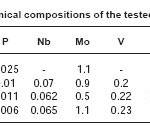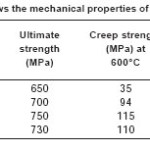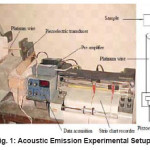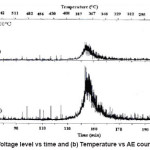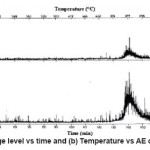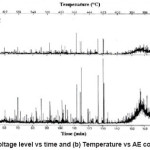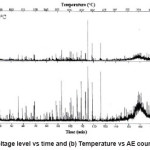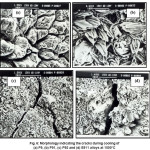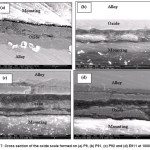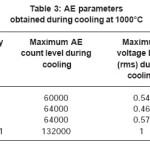Detection of Crack and Spallation of Oxide Scales using Acoustic Emission Technique
P. Mathiazhagan
Pondicherry Engineering College, Pondicherry (India).
DOI : http://dx.doi.org/10.13005/msri/090105
Article Publishing History
Article Received on : 15 Feb 2012
Article Accepted on : 28 Mar 2012
Article Published :
Plagiarism Check: Yes
Article Metrics
ABSTRACT:
Acoustic Emission has been finding increasing application for monitoring of aging infrastructures. The materials undergo degradation mechanism during long service exposure at high temperature. Experiments have been carried out on recently developed steel grades P91, P92 and E911 used in thermal power plant materials using acoustic emission (AE) technique under isothermal oxidation in air at 950°C and 1000°C upto 5h. AE parameters count and voltage level shows negligible during isothermal heating for the alloys at these temperatures until the test duration, however a sudden increase is AE activity is found while cooling. An enormous increase in AE activity occurs after the start of cooling has been related to spallation of oxide layers. A very large increase in AE parameters for P92 and E911 alloy at 1000°C during cooling from this temperature has been related to cracking of oxide scale. The oxidation specimen was analyzed using various surface analytical techniques such as scanning electron microscopy (SEM) and energy dispersive X-ray analysis (EDAX).
KEYWORDS:
acoustic emission; oxidation; cracks
Copy the following to cite this article:
Mathiazhagan P. Detection of Crack and Spallation of Oxide Scales using Acoustic Emission Technique. Mat.Sci.Res.India;9(1)
|
Introduction
Acoustic emission is defined as “the class of phenomena whereby transient elastic waves are generated by the rapid release of energy from localized sources within a materials or the transient elastic waves so generated”1. During manufacturing process of metal every care is taken to have sound metallurgical microstructure. In thermal power plant the components are subjected to high temperatures may result in thicker oxide scales, leading to exfoliation and cause tube blockages in the steam circuit or the spalled oxide be carried into the steam turbine and erode the turbine blades; both of these phenomena are, of course, detrimental to the performance of the power plant, reducing both the life and efficiency2 The oxide scale when reaches upto certain critical value leads to spallation at some regions. The oxide crack and spallation gives rise to energy release. The wave attenuation limits the propagation distances of stress waves. The amplification is done after the sensors detect the activity in order to transmit current long distances without significant loss. In an earlier worker3 have successfully used this technique to detect the breakaway oxidation of oxide layers formed on 2.25Cr –Mo alloy by continuously heating the specimen from ambient to the set temperature. In the present work to detect the crack and spallation of oxide layers of recently developed P92 and E911 alloys have been carried out for monitoring AE and compared to the conventional P9 and P91 alloys.
Material
Experimental Techniques
Four different low alloy steels namely P9, P91, P92 and E911 were obtained from Indira Gandhi Centre for Atomic Research, Kalpakkam and Forschungszentrum Julich, Germany. The chemical compositions of alloys analyzed using inductively coupled plasma and atomic emission spectroscopy (ICP – AES) technique are shown in table 1.
The received materials were cut into the rectangular specimens of size 10x10x2 mm and the samples were polished up to 800 grit using silicon carbide papers, washed in distilled water, cleaned in acetone and air dried before oxidation test. The specimen was spot welded to a platinum wire waveguide (1mm diameter) at one end and to a copper plate at the other end of the wire. A piezoelectric transducer was placed the welded region of the copper plate to capture the AE being transmitted through the platinum wire waveguide. Acoustic emission tests were carried out in a horizontal furnace fitted with a (32mm) diameter Quartz glass tube. The sample is inserted into the hot zone of horizontal muffle furnace when the desired temperature was attained. The furnace was equipped with a PID (Proportional Integral and Derivative) controller to maintain the uniform and desired temperature. AE monitoring was carried out using a Model 204B system supplied by M/S. Acoustic Emission Technology U.S.A. A band pass filter was used along with 60dB fixed gain amplifier. For all the experiments, a total system gain of 100dB and a threshold voltage of 0.68 volt were used. These setting values were estimated after several trial experiments with the objective of maintaining the background noise to an acceptable minimum. The acoustic signal was recorded using a two-pen volt strip chart recorder. An experimental setup is shown in Fig 1. The experiments were carried out in two stages; the 5h isothermal heating for 950°C and 3h heating for 1000°C, after that the furnace electrical power was switched off
Results
The Fig 2-5 bottom plot shows voltage level vs time and top plot shows AE events generated during cooling and inside furnace temperature. The acoustic parameters did not show any activity during the heating for specimen oxidized upto 950 and 1000°C. After temperature peaked and cooling begun and large AE activity has obtained due the stress was sufficiently high. Stress generation leads to increasing elastic energy which is stored in the oxide metal composite. If the oxide layer is thin compared to the thickness of the metallic substrate, the elastic energy is stored mainly in the scale. Exceeding the stress limits locally leads to spontaneous transition from a state of high potential energy to a state of low potential energy. This can happen by the formation of cracks through or within the oxide layer or by partial spallation of the scale. As this process occurs, part of the released energy is emitted as propagating acoustic wave packets which can be detected by piezoelectric sensors, converted to transient voltage signals and analyzed. Acoustic activity noted around 90 and 150 min at 1000°C for P9 and P91 alloys. The acoustic activity started well in advance for P92 and E911 alloys due to cracks and spallation oxide.
Table 1: Chemical compositions of the tested steels (wt %)
Table 2: Shows the mechanical properties of these alloys
Figure 1: Acoustic Emission Experimental Setup
Figure 2: (a) Voltage level vs time and (b) Temperature vs AE count at 1000°C
Figure 3: (a) Voltage level vs time and (b) Temperature vs AE count at 1000°C
Figure 4: (a) Voltage level vs time and (b) Temperature vs AE count at 1000°C
Figure 5(a): Voltage level vs time and (b) Temperature vs AE count at 1000°C
Figure 6: Morphology indicating the cracks during cooling of (a) P9, (b) P91, (c) P92 and (d) E911 alloys at 1000°C
Figure 7: Cross section of the oxide scale formed on (a) P9, (b) P91, (c) P92 and (d) E911 at 1000°C
Surface morphology analysis
Fig.6 shows SEM morphology of the oxide scale formed on the alloys at 1000°C in air. A thick and rosette appearance oxide formed for P9 and P91 alloys (Fig 6 (a-b)). However oxide formed P92 and E911 alloys having a rosette appearance with cracks (Fig 6 (c-d)). Cracks were seen during cooling, which deteriorate the scale adherence and increase the oxidation rate. On the other hand, the growth and thermal stresses generated during oxidation may be accommodated by scale cracking, scale spalling from the alloy surface, and the plastic deformation of the matrix4.
Analysis of Cross Section
Cross sections of selected oxidized specimens analyzed using SEM/EDAX are shown in Fig [7]. The oxide layer seems to be double layer and adhered to the matrix for P9 and P91 alloys. P92 alloy having double oxide layers with spallation in the outer oxide layer. However, E911alloy having double layers with cracks and spallation as shown in 7 (d). The cracks are likely to be related to stresses originating from differences in thermal expansion coefficient between alloy and oxide at high temperatures5 resulting in tensile stresses in the oxide during cooling.
Table 3: AE parameters obtained during cooling at 1000°C
Discussion
The 9% chromium steels developed during the last three decades are of great interest for components such as water wall, superheater, reheater and steam pipe for power plant application. 9Cr -1Mo (P9) and modified 9 – 1Mo (P91) alloys cannot be used at higher temperatures and pressure, because of poor creep strength above 593°C. Supercritical power plants generally operate at temperature more than 600°C. For that advanced materials are needed to withstand high temperature and pressure in term of strength, creep and oxidation resistance. To improve the mechanical properties of materials, a small amount of alloying element such as tungsten (W), niobium (Nb) and vanadium (V) are added to conventional 9Cr -1Mo alloy. However, because of high concentration of ferrite stabilizing elements such as W, Nb and Mo, there are chances of deleterious phase formations such as σ or Laves phase. V and Nb combine with C and or N to produce carbides, nitrides or carbonitrides, which form coherent precipitates and help in precipitation strengthening. Modified alloys with these P92 and E911,these having increased the mechanical properties of alloy are shown in Table 2.
The P92 and E911 alloys with the addition of active elements such as W and Nb, which improve the mechanical strength and creep strength of these alloys but the oxidation resistance of these alloys as the following order P92<E911<P91<P9 [6]. For the comparison of various AE parameters at 1000°C shown in table 3. It can be seen from data, there is an increases in AE parameters for E911 alloy compared with other three because higher amount of molybdenum present in this alloy. There is a general tendency for alloy contains a higher amount of molybdenum to produce more acoustic emission activity7 than other alloys containing low molybdenum levels. Since as a result of thermodynamic calculations molybdenum can form highly volatile hydroxyl species under these conditions it can be suspected that these increase the tendency to scale cracking and may even have an impeding effect on scale healing.
Conclusion
Acoustic emission test was carried out over the temperature range of 950° C and 1000°C. The
following results were obtained.
- The lower the oxidation resistance of alloy (E911) is the more AE activity expected
- Oxide spalling is responsible for a considerable amount of acoustic activity during cooling
- Among the four alloy steels, the acoustic emission was observed in the following order
as E911< P92<P91<P9 at 1000°C
Acknowledgements
The Department of Metallurgical and Materials Science (Corrosion Science and Engg), Indian Institute of Technology Bombay, Mumbai given the lab facility to conduct this experiment during my Ph.D., Programme.
References
- ASTM E1316-94, Standard Terminology for Nondestructive Examinations” American Society of Testing and Materials
- P.J Ennis and A Czyrska Filemonowicz, “ Recent Advances in Creep Resistant steels for power plant applications” OMMI 1 (1) pp 1.28 (2002)
- B.B Jha, A.S.Khanna, Baldev Raj, “Study of the oxidation behavior of 9 Cr -1Mo steel using the acoustic emission technique” Journal of Materials Science 22: 2823 -2827 (1987).
CrossRef
- Dong-Hun Lee, Dong-Bok Lee and Woo- Sang Junga, “High temperature oxidation of Fe-Cr-Mo alloys”, Journal of Ceramic Processing, 7(2): 140-143 (2006).
- J. Z urek, E. Wessel, L. Niewolak, F. Schmitz, T. U. Kern, L. Singheiser, W.J. Quadakkers, “Anomalous Temperature Dependence of Oxidation Kinetics During Steam Oxidation of Ferritic Steels in The Temperature Range 550-650°C Corrosion Science 46: 2301- 2317 (2004).
CrossRef
- P.Mathiazhagan and A.S.Khanna, “Effect of water vapour on the oxidation behavior of modified low alloy steel at high temperatures”, The Arabian journal for science and Engineering 34(2C): 159 -178 (2009).
- M. Schutze, D.Renusch and M. Schorr, “ Parameters determining the breakaway oxidation behavior of ferritic martensitic 9%Cr steels in environments containing H2O”, Corrosion Engineering, Science and Technology 39(2): 157 -166 (2004).
CrossRef
- Bryan C. Morgan and Richard Tilley “Inspection of Power Plant Headers Utilizing Acoustic Emission Monitoring” NDT& E International Journal 32(3): 167-175 (1999).
CrossRef
- A.S.Khanna , B.B.Jha and Baldev Raj, “Detection of Breakaway oxidation and spalling in the oxide scales of 2.25Cr -1Mo Steel using acoustic emission technique”, Oxidation of metal, 23(3-4): 159 -176 (1985)
CrossRef
- W.Christl, A.Rahmeland M.Schutze, “Application of the acoustic emission technique for the detection of oxide scale cracking during thermal cycling” Materials science and Engineering 87: 289-293 (1987).
CrossRef
- S. Rajendranpillai, N. Sivaibarasi, H.S. Khatakand J.B.Gnanamoorthy,”Effect of external stress on the behavior of oxide scales on 9Cr-1Mo steel:”,Oxidation of metals , 49(5/6): (1998).
- H.J.Schmutzler and H.J.Grabke, “Application of an acoustic emission technique to the high temperature oxidation of Fe-Cr- Al alloys”, oxidation of metals, 39(1/2): (1993).
- B.B Jha, B.Raj, A.S.Khanna, D.K. Bhattacharya,” Correlation of acoustic emission events with parabolic oxidation behavior of 2.25Cr-1Mo steel”, Journal of materials science letters 10: 64-66 (1990).
CrossRef

This work is licensed under a Creative Commons Attribution 4.0 International License.
 Material Science Research India An International Peer Reviewed Research Journal
Material Science Research India An International Peer Reviewed Research Journal

